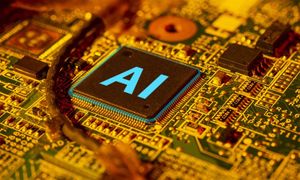
The technology sector, a bellwether of innovation and economic growth, is experiencing a robust rebound and significant consolidation as of November 2025, charting a new course after enduring a challenging period of market decline from late 2022 through parts of 2024. This resurgence is primarily propelled by the transformative power of artificial intelligence (AI), coupled with an improving macroeconomic landscape characterized by anticipated interest rate cuts and strong global IT spending. The immediate implication for the market is a renewed sense of optimism, though tempered by evolving regulatory complexities and a fierce battle for dominance among tech giants.
This period marks a pivotal moment for the tech industry, as companies strategically realign, invest heavily in cutting-edge AI capabilities, and engage in a flurry of mergers and acquisitions to solidify their positions. The shift from a cautious, cost-cutting environment to one focused on aggressive innovation and market expansion signals a new chapter, promising both significant opportunities and potential disruption across the digital economy.
Navigating the Storm: From Rout to Resurgence
The recent stock market rout, which heavily impacted the tech sector from late 2022 through parts of 2024, was a confluence of several formidable headwinds. High inflation, a rapid succession of interest rate hikes by central banks globally, and persistent geopolitical tensions created an environment of uncertainty, dampening consumer and enterprise spending. Rising borrowing costs particularly squeezed tech companies, making expansion more expensive and diminishing the present value of future earnings in investor valuations. Many prominent tech firms reported mixed earnings and undertook significant workforce reductions, leading to considerable drops in their market capitalizations during this turbulent period.
However, the tide began to turn in 2024, leading to the current robust rebound in 2025. The primary catalyst for this recovery is the explosive growth and application of generative AI. Companies are now injecting AI into every facet of their digital transformation strategies, with hyperscalers like Alphabet (NASDAQ: GOOGL), Amazon (NASDAQ: AMZN), Meta (NASDAQ: META), Microsoft (NASDAQ: MSFT), and Oracle (NYSE: ORCL) projecting massive capital expenditures for AI infrastructure. Global AI-related investments are anticipated to reach an staggering $200 billion by the end of 2025. This technological leap is being further bolstered by the widespread expectation of interest rate cuts by the Federal Reserve in 2024 and 2025, which promises to reduce borrowing costs, stimulate investment, and boost valuations across the sector.
The market has reacted with renewed vigor. Global IT spending is projected to grow by a robust 9.3% in 2025, reaching $5.74 trillion, with software and data center segments leading the charge with double-digit growth. The S&P 500 Technology sector has shown significant earnings growth, particularly in Q2 2025, with strong projections for the latter half of the year. This favorable environment is also spurring significant sector consolidation, with mergers and acquisitions (M&A) playing a crucial role. For instance, in a notable move in November 2025, Microsoft (NASDAQ: MSFT) acquired Synapse AI for $9.5 billion, underscoring the strategic imperative to acquire specialized AI capabilities. Private equity firms, armed with substantial capital, are also actively participating, seeking to capitalize on technology gaps and scale operations in areas like cloud services and cybersecurity.
The Shifting Sands: Who Wins and Who Loses in the New Tech Era
The current tech sector rebound and consolidation are creating a distinct landscape of winners and losers, with AI innovation and access to capital acting as primary determinants of success. Companies at the forefront of AI development and infrastructure are poised for significant gains, while those with less differentiated offerings, high capital burn rates, or business models vulnerable to AI disruption face considerable headwinds.
Among the clear winners are the foundational players in the AI revolution. Nvidia (NASDAQ: NVDA) continues its dominance in AI chips, particularly Graphics Processing Units (GPUs) that are indispensable for powering AI data centers. The surging demand for its hardware, coupled with its established market position and high barriers to entry, makes it a direct beneficiary of the ongoing AI arms race. Similarly, cloud computing giants are thriving. Alphabet (NASDAQ: GOOGL, GOOG), through its Google Cloud and integrated Gemini AI products, is demonstrating strong financial performance, bolstered by its substantial cash flow that funds continuous AI infrastructure investment. Microsoft (NASDAQ: MSFT), with its leading Azure cloud platform and strategic partnership with OpenAI, is deeply entrenched in the AI ecosystem, seeing increased demand for its cloud services. Amazon (NASDAQ: AMZN) and its Amazon Web Services (AWS) division are also critical infrastructure providers for AI workloads, rapidly adopting custom AI chips like Trainium2. Chipmakers like Advanced Micro Devices (NASDAQ: AMD), which produce processors capable of powering AI technology, and Micron Technology (NASDAQ: MU), benefiting from the rebound in memory chip demand driven by AI's vast data requirements, are also well-positioned. These companies benefit not only from AI demand but also from the anticipated interest rate cuts, which lower the cost of capital for their massive R&D and infrastructure investments.
Conversely, several companies and segments face significant challenges. Smaller, undifferentiated AI startups that raised capital on speculative valuations during the hype cycles of 2021-2022 are now struggling. Many have high burn rates, lack clear paths to profitability, and face intense competition from well-funded giants and increasingly sophisticated open-source AI models. Venture capital funding for these speculative ventures is drying up, leading to "down rounds" or outright failures, making them prime targets for distressed M&A. Even some tech behemoths face scrutiny: Meta Platforms (NASDAQ: META), despite its strong AI ambitions, has encountered market pushback over the vast capital expenditure required for its AI and metaverse projects without immediate, clear returns. Tesla (NASDAQ: TSLA) has seen disappointing earnings and narrowing automotive margins, with its long-term AI-driven ambitions in robotics and autonomous systems met with investor skepticism regarding their ability to offset near-term pressures. Traditional software companies like Adobe (NASDAQ: ADBE) are grappling with fears that generative AI could disrupt demand among their core creative user base, potentially eroding market share. Apple (NASDAQ: AAPL), while still a tech titan, is experiencing slowing sales growth and cautious market responses to its significant AI infrastructure investments, as direct revenue generation from these efforts isn't as immediately apparent as with other tech giants. Lastly, companies like Marvell Technology (NASDAQ: MRVL) have seen stock drops due to concerns about losing major custom chip contracts with hyperscalers, highlighting the intense competition and shifting strategies in the AI supply chain.
Wider Significance: Reshaping the Digital Landscape
The tech sector's vigorous rebound and strategic consolidation are not merely isolated market events but signify a profound reshaping of the broader digital landscape. This period is characterized by a strategic pivot from pure efficiency to "efficient growth," with companies making targeted, high-impact investments, predominantly in AI. Global IT spending is projected to surge by 9.3% in 2025, reaching an estimated $5.74 trillion, with AI, cloud computing, and cybersecurity absorbing the lion's share of this capital. AI is rapidly transitioning from a specialized vertical to a foundational infrastructure layer, driving an "AI capex surge" that sees over $1 billion per day invested in AI-related infrastructure, research, and development by tech giants.
These trends have significant ripple effects across the industry. For competitors, the intense consolidation, marked by "higher value, lower volume" M&A, can lead to reduced competition, potentially fostering market dominance and vendor lock-in by behemoths like Amazon Web Services (NASDAQ: AMZN), Microsoft Azure (NASDAQ: MSFT), and Google Cloud (NASDAQ: GOOGL). Smaller players face immense pressure to innovate or become acquisition targets, fueling an "arms race for AI expertise." Partners, including integrators and managed service providers, are also consolidating to meet the complex demands of AI rollouts, building new capabilities through M&A. Strategic partnerships and joint ventures are increasingly favored alternatives to traditional M&A, allowing companies to offer more comprehensive solutions, enhance data governance, and expand customer bases. Global consultancies are actively acquiring digital agencies and AI consulting startups to accelerate their digital transformation offerings.
The increased scale and influence of the tech sector, particularly with the rise of AI, are inevitably drawing heightened regulatory scrutiny. The European Union's landmark AI Act, which formally entered into force in August 2024, is a prime example. Its phased implementation in 2025 introduces significant compliance obligations, with key deadlines in February 2025 for banning "unacceptable risk" AI systems and mandating AI literacy, followed by rules for providers and deployers of general-purpose AI systems (like large language models) in August 2025. Businesses face substantial "AI compliance taxes" through costs for experts, documentation, and auditability, with non-compliance risking hefty fines up to 6-7% of global annual turnover. Concerns linger that these stringent requirements could stifle innovation, especially for European startups, and potentially consolidate power among larger players better equipped to manage compliance costs. Beyond AI-specific regulations, antitrust pressure is mounting globally, with regulators scrutinizing large-scale tech consolidation and even smaller AI-related deals, fearing early market concentration in a strategically critical sector. The U.S. Department of Justice, for instance, continues its investigations into dominant players like Google (NASDAQ: GOOGL) for antitrust violations in search and advertising.
Historically, the current market environment, with its exuberance around AI, draws parallels to the dot-com bubble of the late 1990s and early 2000s. Similarities include elevated valuations in the AI sector and a market heavily concentrated on a few mega-cap tech companies, with giants like Nvidia (NASDAQ: NVDA), Apple (NASDAQ: AAPL), and Microsoft (NASDAQ: MSFT) reaching multi-trillion-dollar valuations. However, crucial distinctions exist: unlike many dot-com era companies that lacked fundamental profitability, today's tech leaders generally boast strong underlying revenue and profits. Nevertheless, the immense capital expenditures required for AI development could still lead to further consolidation and potential antitrust challenges. History also teaches that markets often rebound from shocks, and while sustained highs can precede corrections, the current rebound is underpinned by tangible technological advancements rather than pure speculation.
What Comes Next: A Future Forged in AI and Strategic Adaptation
The tech sector's journey of rebound and consolidation is far from over; it marks the beginning of a new era defined by accelerated AI integration and strategic recalibration. In the short term (next 1-2 years, 2026-2027), generative AI will transition from experimental pilot projects to full-scale production, with a laser focus on demonstrating tangible return on investment (ROI). Enterprises are expected to deeply embed AI into their operating models and product offerings, aiming for both top-line growth and bottom-line efficiency. Agentic AI systems, capable of autonomously managing complex workflows, are anticipated to be piloted by approximately 25% of enterprises by 2025, fundamentally altering automation and decision-making processes. Cybersecurity will remain a paramount concern, with escalating threats driving demand for AI-driven security solutions, extended detection and response (XDR), and cloud-native protection. The insatiable demand for AI's computing power will continue to fuel massive investments in cloud infrastructure and data centers, while the job market will see a sustained shift towards highly specialized roles in AI, cybersecurity, and cloud.
Looking further into the long term (3-5+ years, 2028-2030 and beyond), AI's transformative impact is expected to unfold for decades, creating entirely new business models and significant economic value across all industries. This will include the emergence of next-generation AI, such as more sophisticated agentic AI, which will redefine human-machine collaboration. Beyond AI, frontier technologies like digital twins, quantum computing (though still nascent for most commercial ROI), immersive technologies (Augmented Reality/Extended Reality), and advanced robotics are poised for broader adoption. Sustainable technology will become a core pillar, with the green tech market projected to reach hundreds of billions by 2030, driven by AI, analytics, and stricter ESG compliance. The convergence of cloud, edge computing, and advanced connectivity (5G and eventually 6G) will enable low-latency processing and highly distributed data management, powering novel applications and services. The trend of consolidation will likely persist, with larger tech players acquiring niche providers to offer comprehensive, end-to-end solutions, potentially leading to the further entrenchment of "walled gardens" by dominant tech giants.
To navigate this evolving landscape, tech companies are undertaking significant strategic pivots. There's a clear shift towards prioritizing profitability and sustainable growth over rapid, unbridled expansion. Companies are urged to adopt an "AI-first" mindset, fundamentally rethinking and reinventing their operations by integrating AI internally before offering external solutions. Elevated risk management, encompassing geopolitical tensions, escalating cyber threats, and sustainability concerns, is becoming central to corporate strategy. Supply chain resilience, achieved through diversification across trusted regions, is also gaining prominence. Strategic M&A is focusing on mid-market opportunities with stable cash flows and scalable business models, particularly for AI-native and infrastructure software companies, with ESG considerations becoming more prominent in deal evaluation. Furthermore, companies are exploring outcome-based pricing models for AI solutions to better align value with customer results, alongside robust data strategies and cloud optimization efforts.
The market opportunities are vast, primarily centered on AI across its various forms (generative, agentic, infrastructure), cybersecurity, sustainability/green tech, healthcare technology, enterprise software and automation, and immersive technologies. However, significant challenges loom, including the increasing sophistication of cyber threats (including AI-driven malware), geopolitical tensions, an increasingly complex regulatory landscape, persistent talent shortages, the massive energy consumption of AI and data centers, economic uncertainty, and crucial concerns around trust and ethical AI.
Ultimately, the tech sector's future could unfold in several potential scenarios. We might see AI-driven hypergrowth, characterized by rapid innovation, widespread agentic AI adoption, and significant productivity gains. Alternatively, a scenario of consolidation and dominance by tech giants could emerge, where a few hyperscalers control key AI infrastructure and ecosystems. Increased regulatory intervention and ethical tech could shape the industry, leading to stricter compliance but fostering a more trustworthy environment. A sustainability-first tech transformation could prioritize green technologies and energy efficiency. Or, despite broader consolidation, a vibrant ecosystem of fragmented but innovative niche markets could continue to thrive, particularly in specialized areas of AI, biotech, and quantum computing. Success will hinge on adaptability, strategic risk management, and the ability to convert technological prowess into sustainable value.
Comprehensive Wrap-up: A Transformed Tech Landscape
As of November 2025, the tech sector stands at a pivotal juncture, having successfully navigated a recent market rout to enter a phase of robust rebound and strategic consolidation. The undeniable force driving this transformation is Artificial Intelligence, which has become the central engine of innovation, investment, and market restructuring.
Key takeaways from this period include the monumental capital expenditures by tech giants like Microsoft (NASDAQ: MSFT), Alphabet (NASDAQ: GOOGL), Meta (NASDAQ: META), and Amazon (NASDAQ: AMZN) into AI infrastructure, particularly semiconductors and cloud expansion. This has fueled a significant M&A rebound, with a focus on higher-value deals in areas such as applied AI, post-quantum cybersecurity, healthtech, ClimateTech, and Vertical SaaS, exemplified by Cisco's (NASDAQ: CSCO) acquisition of Splunk (NASDAQ: SPLK). While the S&P 500 and Nasdaq have seen strong rebounds, recent concerns about "bubbly valuations" in some AI-related stocks signal a maturing market that is increasingly scrutinizing sustainable business models over pure speculative growth. Crucially, today's leading tech companies generally possess more grounded valuations and stronger balance sheets compared to the dot-com bubble era, suggesting a more resilient foundation.
Moving forward, AI will continue its dominance, transitioning from a "picks and shovels" phase (AI 1.0) focused on hardware to a software and monetization-centric era (AI 2.0). This shift will unlock significant opportunities for companies that can effectively integrate and monetize AI within their products and services. Strong growth is anticipated across semiconductors, cloud computing, cybersecurity, Fintech (with a notable boost to cryptocurrency, including Bitcoin at record levels, due to anticipated friendly regulation), Healthtech, ClimateTech, Autonomous Robotics, and even Utilities, which are seeing surging power demand from AI data centers. While M&A will persist, driven by the need for scale and technological assets, concerns about potential distress in the data center industry due to rising energy costs and competition could lead to further consolidation in that segment. Macroeconomic factors, including stabilizing or potentially lower interest rates, are generally supportive, though persistent inflation, private credit concerns, and geopolitical uncertainties are headwinds.
The significance and lasting impact of this era are profound. AI is fundamentally reshaping competitive dynamics, fostering an unprecedented convergence across software, data, and hardware ecosystems. The investment narrative has unequivocally shifted from "growth-at-all-costs" to a disciplined focus on profitability and sustainable value creation. This period is not just a market cycle; it is defining how technology integrates into every aspect of business and daily life, establishing a new paradigm for innovation and economic contribution built on a more resilient, AI-powered foundation.
For investors in the coming months, vigilance and strategic discernment are paramount. Watch closely for sustainable AI valuation and monetization strategies, observing the transition from hardware-centric AI to software and services. Corporate earnings and guidance from major tech players, especially those heavily invested in AI (such as Nvidia's mid-November report), will offer critical insights into market health. Monitor central bank decisions on interest rates, inflation data, and labor market trends for macroeconomic cues. Geopolitical developments, including trade policies and export restrictions on advanced AI chips, could impact global supply chains. Assess the long-term demand visibility and sustainable returns from massive data center investments. Keep an eye on M&A activity, particularly in strategic verticals like cybersecurity and applied AI, and evaluate new IPOs in AI, fintech, and cryptocurrency for robust growth strategies. Finally, broaden your view beyond pure tech to supporting sectors like utilities and communication services, which are also benefiting from this transformative period.
This content is intended for informational purposes only and is not financial advice





